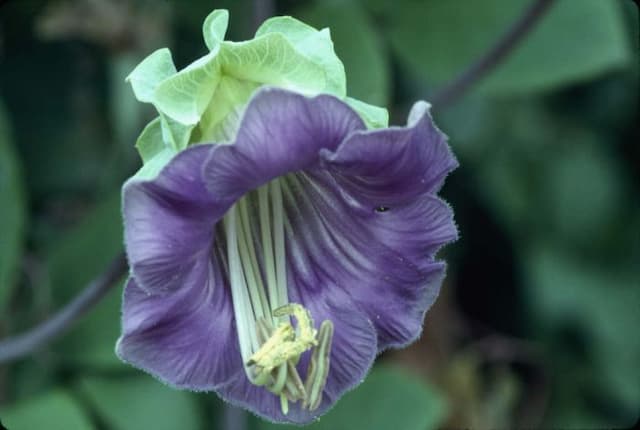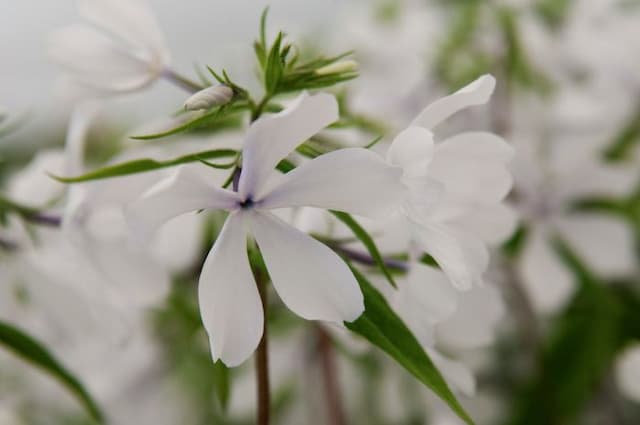Perennial phlox 'Blue Boy' Phlox paniculata 'Blue Boy'

ABOUT
'Blue Boy' is a strong-growing herbaceous perennial 90-120cm high with green lance-shaped leaves and large clusters of scented, mauve-blue flowers, with darker purple and white eyes, from summer to early autumn
About this plant
 Names
NamesSynonyms
Garden Phlox, Summer Phlox, Perennial Phlox, Tall Phlox
Common names
Phlox paniculata 'Blue Boy'
 Characteristics
CharacteristicsLife cycle
Perennials
Foliage type
Deciduous
Color of leaves
Green
Flower color
Lavender
Height
2-4 feet [0.6-1.2 meters]
Spread
2-3 feet [0.6-0.9 meters]
Plant type
Herb
Hardiness zones
4-8
Native area
North America
Benefits
 General Benefits
General Benefits- Aesthetic Appeal: Adds a vibrant blue-purple color to gardens, creating beautiful landscapes.
- Attracts Pollinators: Provides nectar for butterflies, hummingbirds, and other pollinators, enhancing biodiversity.
- Fragrance: Releases a pleasant scent which can add an aromatic dimension to gardens.
- Ease of Care: Summer Phlox is known for being low-maintenance and easy to grow, suitable for gardeners of all levels.
- Long Blooming: Flowers from mid to late summer, providing color for an extended period.
- Border Plants: Ideal for use in borders due to their upright growth habit and long stems.
- Cut Flowers: The blooms are suitable for cutting and can be used in floral arrangements.
 Medical Properties
Medical PropertiesThis plant is not used for medical purposes.
 Air-purifying Qualities
Air-purifying QualitiesThis plant is not specifically known for air purifying qualities.
 Other Uses
Other Uses- Garden boundary definition: Garden Phlox can be planted in rows to create a colorful, natural border that defines different areas of a garden.
- Pressed flower art: The vibrant flowers of the Garden Phlox can be pressed and used to create beautiful artwork or to embellish greeting cards.
- Photography subject: The striking hues of Garden Phlox provide a captivating subject for photographers looking to capture the beauty of flowers in their natural setting.
- Natural dye: The petals of Garden Phlox can be used to create a natural dye for fabrics, giving them a soft, subtle color.
- Educational tool: Garden Phlox can be used in educational settings to teach students about plant growth, pollination, and horticulture practices.
- Culinary decoration: While not commonly consumed, the flowers of Garden Phlox can be used as an ornamental garnish for culinary dishes, adding flair and color.
- Aromatherapy: While typically not noted for its scent, Garden Phlox can contribute to a calming garden atmosphere, which may be beneficial for relaxation and stress relief.
- Composting: The spent blooms and foliage of Garden Phlox can be added to compost bins to help create nutrient-rich compost for gardens.
- Fragrance extraction: In some cases, the subtle scent of Garden Phlox flowers can be used in the production of lightly scented oils and perfumes.
- Art inspiration: The diverse color palette of Garden Phlox blooms can serve as an inspiration for artists working in various mediums, from watercolor to textile design.
Interesting Facts
 Feng Shui
Feng ShuiThe garden phlox is not used in Feng Shui practice.
 Zodiac Sign Compitability
Zodiac Sign CompitabilityThe garden phlox is not used in astrology practice.
 Plant Symbolism
Plant Symbolism- Unity and Harmony: The dense clusters of flowers on the Phlox paniculata 'Blue Boy', or Garden Phlox, symbolize individuals coming together in unity to create a harmonious whole. This can reflect the importance of teamwork and collaboration.
- Sweet Dreams: Garden Phlox has a soft and calming fragrance that is often associated with inducing sweet dreams, making it a symbol for a peaceful and restful night.
- Proposal: In the language of flowers, giving someone a bouquet of Garden Phlox can symbolize a marriage proposal or the intent to start a romantic relationship.
- Agreement: Garden Phlox is sometimes used to symbolize agreement or unity of opinion, reflecting the way the flowers themselves come to agreement in their shape and structure.
 Water
WaterGarden Phlox should be watered deeply once a week, with about one inch of water. The soil should be kept moist but not soggy. During hot or dry periods, increase watering to twice per week. It's essential to avoid overhead watering to prevent mildew issues, so water at the base of the plant using a soaker hose or drip irrigation. During the winter, reduce watering since the plant's water requirements decrease as it goes dormant.
 Light
LightGarden Phlox thrives in full sun to partial shade. It prefers a location that receives at least six hours of direct sunlight daily, which promotes vigorous growth and abundant blooms. However, in very hot climates, a spot with afternoon shade can help protect the plant from intense, potentially damaging heat.
 Temperature
TemperatureGarden Phlox is hardy and can survive in temperatures as low as -30 degrees Fahrenheit and as high as 90 degrees Fahrenheit. However, the ideal growing temperature range is between 60 and 80 degrees Fahrenheit. This plant is quite adaptable but may struggle in extreme heat without adequate moisture or in regions with very mild winters.
 Pruning
PruningPrune Garden Phlox to improve air circulation, shape the plant, and promote vigorous growth. Deadheading spent blooms throughout the flowering season encourages more flowers. After the first killing frost in fall or early winter, prune the stems back to two inches above ground level to prepare for winter and promote healthy new growth in the spring.
 Cleaning
CleaningAs needed
 Soil
SoilGarden Phlox prefers rich, loamy soil with good drainage and a pH ranging from 6.0 to 7.5. The best soil mix can be created by combining garden soil, compost, and perlite or coarse sand to ensure proper drainage. It's important to enrich the soil with organic matter to promote vigorous growth and blooming.
 Repotting
RepottingGarden Phlox, being a perennial, does not need frequent repotting. Repot or divide the plant every 3 to 4 years to rejuvenate and prevent overcrowding. Do this in the spring before new growth begins or in the fall after blooming has finished.
 Humidity & Misting
Humidity & MistingGarden Phlox thrives in average outdoor humidity levels. As long as the plant is watered adequately and the soil moisture is maintained, ambient humidity should not be a major concern. Avoid overly humid conditions which can encourage fungal diseases.
 Suitable locations
Suitable locationsIndoor
Ensure bright light and good air circulation.
Outdoor
Full sun to partial shade and moist soil.
Hardiness zone
4-8 USDA
 Life cycle
Life cyclePhlox paniculata 'Blue Boy', commonly known as garden phlox 'Blue Boy', begins its life as a seed that germinates in moist, well-drained soil in early spring. After sprouting, the seedling develops into a vegetative state with a rosette of leaves at the soil surface, followed by upright stems. During its growth phase, the plant forms a clump of stems and foliage, and in summer, it produces clusters of blue-violet flowers that attract pollinators. After flowering, the plant sets seed, which can be dispersed by wind or wildlife to propagate the species. In fall, the above-ground portions of the plant die back with the onset of colder temperatures, while the roots remain dormant underground. The following spring, new growth emerges from the surviving root system, thus continuing its perennial cycle.
 Propogation
PropogationPropogation time
Spring-Summer
Propogation: Phlox paniculata 'Blue Boy', commonly known as Garden Phlox, is most effectively propagated by root division. The best time to propagate Garden Phlox by division is in early spring or early fall when the plant is not in active growth. To propagate by division, carefully dig up an established clump of phlox and gently separate it into smaller sections, ensuring that each section has a good portion of roots and shoots. These divisions should be replanted promptly at the same soil depth they were originally growing and watered well. This method allows for the new plants to establish themselves before the stress of either the summer heat or winter cold. By dividing every 3 to 5 years, not only will propagation occur, but it will also rejuvenate the parent plants, promoting vigor and better flowering.









